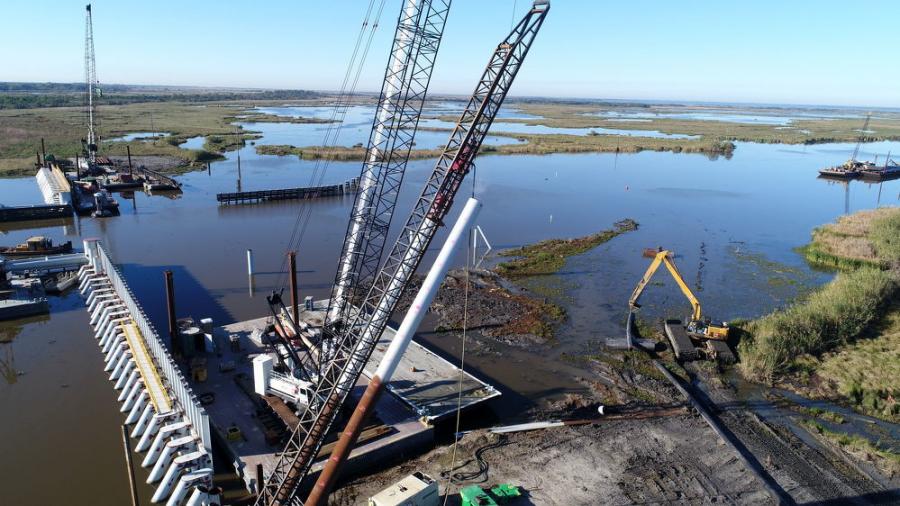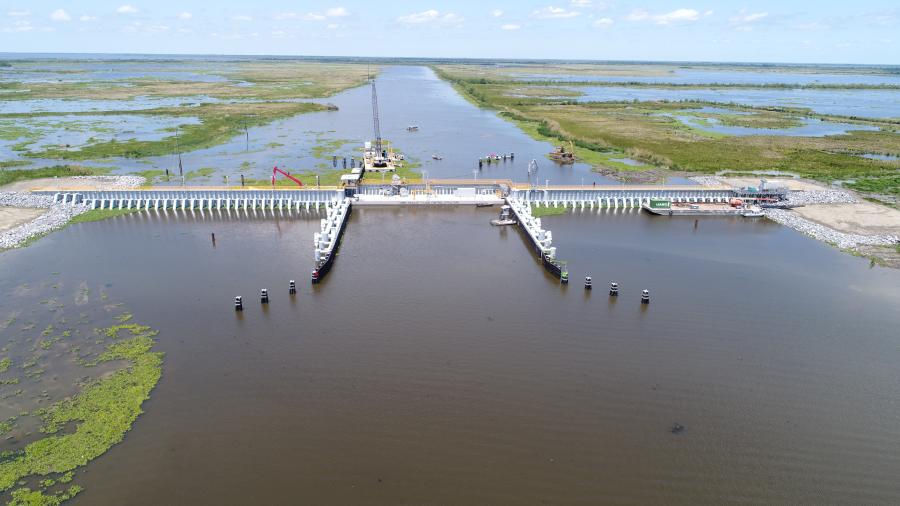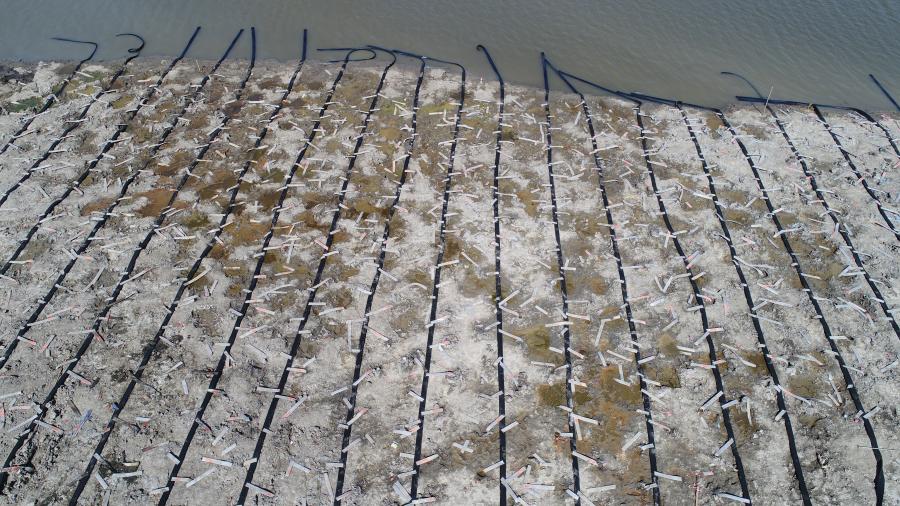When the barge gate is not being utilized for flood protection, it remains open for marine traffic.
(Sealevel Construction Inc.photo)
The Terrebonne Levee & Conservation District (TLCD) and the Louisiana Coastal Protection & Restoration Authority (CPRA) are taking the lead on the U.S. Army Corps of Engineers' $10.3 billion Morganza to the Gulf Hurricane Protection Project in Louisiana, which so far has received an investment of more than $450 million in construction work for levees and floodgates.
"Morganza to the Gulf is a federally-authorized hurricane and storm damage risk reduction project in Terrebonne Parish," explained Ricky Boyett of the USACE's New Orleans District. "However, the Corps has not received appropriations necessary to engage in the construction of the project. In a commendable effort on the part of the local authorities and residents, the TLCD is underway with construction of the project using state and local funds.
"This project is a critical project for reducing damages in this area that result from hurricane and storm surge," Boyett added. "Recently, the Corps and state of Louisiana have collaborated in an effort to reduce the anticipated construction costs from the initial $10.3 billion to an estimated $3.2 billion. We believe that this reduction in cost makes the project more competitive for funding on the national level. The Corps of Engineers New Orleans District considers this project one of our highest priorities, and we are eager to join the state and parish authorities in its construction should necessary funding become available."
The initiative will see construction of approximately 98 miles of earthen levee with 20 floodgate structures proposed for the navigable waterways, along with a lock complex in the Houma Navigational Canal (HNC) that includes a 250-ft. wide steel barge floodgate and a lock measuring 110 ft. wide by 800 ft. long.
In 2013, TLCD built the HNC's "Bubba Dove" Floodgate for a cost of $52 million. This steel barge floodgate is 273 ft. long, 60 ft. wide and 42 ft. high. It has a sill depth of 24 ft. and a floodwall height of 18 ft.
"The floodgate is the crown jewel of our state and local efforts to build parts of our federal hurricane protection project with no federal money," said TLCD Executive Director Reggie Dupre. "This is one of the largest non-federal flood control structures in the nation."
CPRA and TLCD are currently working on the final design of converting the Bubba Dove Floodgate to a lock complex. This new project is being funded from a $400 million grant from the Restore Act, part of the BP oil spill funding. Construction is expected to begin in early 2020 and will be done in three construction phases over the next few years.
Morganza to the Gulf first started in 1992, when Congress authorized the Corps to study the area for the need for hurricane protection. To date, $72 million of federal funding has been spent on this project with no construction funding. This project has been authorized by Congress three times — first in 2000, then in 2007 and finally in 2014.
Post-Katrina design standards have caused the project estimate to increase from $886 million (2007 authorization) to $10.3 billion (2014 authorization). Recently costs have been reevaluated by the Corps using the TLCD's actual construction methods, which reduced the overall price by about 70 percent. The Corps is the federal sponsor for this project, with the CPRA and TLCD jointly serving as local sponsors. Once completed, the TLCD will provide operations and maintenance services for the system.
The project has four major benefits: inundation reduction to provide protection against tidal and hurricane surges up to a Category 3 storm; water supply protection to eliminate over $200,000 in annual water treatment costs; environmental benefits to help protect marshes and wetlands in the Terrebonne Basin; and providing safe harbor to local fisherman, who will no longer have to leave the area in a storm event.
Work on the project began in 2009 and several contracts have been issued: Low Land Construction Co. Inc. and Onshore Materials LLC for levee construction and Sealevel Construction Inc. for structures and floodgates.
Soil conditions complicate the work and make it expensive.
"These are very soft and sometimes unstable soils and we have to do borings to help prepare construction plans," explained Dupre, a former state senator and lead author of the legislation that created the CPRA following Katrina. "All of southern Louisiana, especially in Terrebonne and Lafourche parishes, are at the bottom of the Mississippi River Delta, and most of the work we're doing is taking place in wetlands. Another challenge is building mitigation — for every acre of wetlands of wetlands we impact, we have to build 1.5 acres of new wetlands."
When Hurricanes Katrina and Rita struck the area in 2005, they created 9.5-ft.-tall tidal surges that flooded thousands of homes. Prior to 2005, the area was affected by six major storms going back to the 1980s.
"We would have to move — it's a matter of survival for us without these new structures," Dupre said. "For Hurricane Barry, we had tidal surge over nine feet. With Rita, over 11,000 homes were flooded in Terrebonne Parish and with Barry, 10 or 11 were flooded due to the work we did. Just look at the cost savings of not having flood insurance claims and public assistance. We probably will have $6 million in FEMA claims, but it's not hundreds of millions and our economy continues to work."
The levees and floodgates have and are being designed by the Corps and various engineering firms. Dupre stressed that the new structures will protect three generations of local residents.
"Constructing a large-scale protection system presents many challenges, especially in Terrebonne and Lafourche parishes, where so many natural waterways and canals exist," said Mitchell Marmande, program manager of Morganza to the Gulf. "Managing the hydrology of the system is always a critical design issue as we begin to analyze these levees and floodgates. Couple that with poor soil conditions and environmentally sensitive areas, and the challenges can be multiplied. Managing all these factors while trying to achieve budgets has been something that would not be possible without the focus and commitments of the CPRA, USACE and the hard work of the TLCD's staff and commissioners.
"The hard structures have life spans ranging from 50 to 100 years while the levee alignments while be periodically lifted and improved over time," Marmande added. "In the eleven years I have served as program manager, the concepts and designs have improved greatly as we continue to build each structure, including the massive HNC Lock complex. For the most part we have utilized ‘in the wet' construction to reduce construction time and costs. In addition, we have relied on local expertise in marine construction to constantly improve our designs and construction techniques. However, I believe the greatest benefit our local marine industry provides through the many shipyards and fabricators will be the reduction of operation and maintenance costs over time."
Building a levee to its specified height — in this case about 20 ft. tall — requires years of work. According to Dupre, you have to build them with lifts. "You build it first to 12 ft. and it settles down to 10 ft.," he said. "Then you come back a few years later and go to 15 ft. and it will settle to 13 ft. It may take as many as four lifts to reach your final elevation, and you're constantly having to maintain it because settlement is the nature of the beast in south Louisiana."
The goal, according to the federal report, is to complete the project by 2035. However, Dupre stated that the project hasn't received a dime from the federal government for construction, so it will likely be completed past his own lifetime. Future work for levees and floodgates will be conducted as the project receives funding, with contracts issued for particular elements.
Sealevel Construction Inc. has constructed two floodgates — the Bayou Pointe Aux Chenes ($12.7 million in 2017) and the Falgout Canal (around $35 million in early 2019). The company is awaiting confirmation of the final designs for two more — the Minor's Canal and another along the Inter-coastal Waterway. Sealevel Construction has also built small sections of levees adjacent to the floodgates.
Currently, Sealevel is working on two navigational locks by converting two old sector floodgates — the Boudreaux Canal Lock in Chauvin for $7.6 million and the Bayou Terrebonne Lock in Montegut for $8.4 million.
"These two projects are being built by the Terrebonne Parish consolidated government," Dupre explained. "Sealevel is a local contractor that has done a great job in building these protection projects."
The construction of the first two floodgates went smoothly.
"The biggest challenge is working in the marsh and existing soils," said Justin Lane, Sealevel's project manager. "The area was built by thousands of years of river settlement and it's very soft. You can't do any work with tracked equipment without prepping the location first. There's a lot of subsidence with the sediment being cut off by the levees on the Mississippi. The terrain is very flat, often referred to as marsh."
A typical work site requires the digging of access channels to bring in the barges that house various types of equipment and machinery. Key lessons learned on the construction of the first floodgate dealt with the use of heavy lifts and the means and methods of installing the jackets.
"Once you get below the mud line, the soils vary and in some of those areas you'll run into sand layers and occasional clays," Lane said. "It's all dependent upon the location of the structure and you act accordingly. The levee district is easy to work with. They understand what contractors go through — the topography and things that can come up. Typically, they will hire an engineering or design firm that will do the construction administration, field inspection work, RFIs and deal with design conflicts that may come up."
Quality control covers the fabrication of materials and the actual work.
"A lot of the structures consist of steel materials, such as the pipe pile, and they are subject to NDE performance tests at the fabrication facilities," Lane explained. "They are placed in saltwater environments and coating is an important component, so there are inspections performed prior to any materials being delivered to ensure quality control. From a contractor's standpoint, we hold our suppliers to high standards and make sure they submit documentation for any item they manufacture or provide so that it meets specifications. During construction, the engineer will have a representative on-site to ensure it is done properly — there's a long list of steps that have to be taken."
Sealevel prefers to hire locally, taking on people who have experience in marine and civil construction. The crew members are aware of the importance of their work, Lane noted. Because the soil conditions are not construction-friendly, pilings were required for the floodgates and before any work could begin, engineers performed test borings that were later used to determine the required pile length.
"The floodwall and jacket pile were excessively long for the Falgout Canal project, some in excess of 200 ft.," Lane said. "When we build a floodgate, typically we start from the center with the jacket structures and work our way to the outsides. The Bayou Pointe Aux Chenes project was a very tight area to work — we had a highway on one side and wetlands/marsh on the other side that we could not use for access."
Each of the completed floodgates, built one after another, took about 18 months to complete. The construction is based on five steps: hydraulic dredging to allow for marine navigation, installation of jacket or support structures, plumb and batter pile for the floodwall construction, sheet pilings for the floodwall and finally barge gate fabrication and installation. The work is conducted mainly via dayshifts, with one or two 24-hour shifts over the course of a project.
Each project comes with its own Department of Environmental Quality permits, with DEQ officials making periodic visits to ensure that the regulations and guidelines are being followed. Additionally, the U.S. Coast Guard visits the site occasionally with this project being marine-focused.
Peak days saw 15 to 20 people on-site for Bayou Pointe Aux Chene and around 35 workers for Falgout Canal. Key subcontractors for both floodgates included Bayou Country Survey, Chris Rodrigue Electrical and MDI Inc. for the dredging.
Sealevel uses a wide variety of equipment, including: Cranes (Terex, Link Belt and Manitowoc), Marsh Buggy excavators, large material handling excavators, spud and material barges, tugboats, crew boats, pile hammers, extractors, excavators and dozers. This equipment also includes Komatsu and Caterpillar models.
"We don't really have wear and tear issues with equipment, however when issues come up, we have mechanics within the company that will come on-site and make the repairs," Lane said. "Proper coating and greasing are imperative when dealing with saltwater conditions."
The company purchases and rents equipment from dealerships such as State Machinery Equipment Sales & Rentals in Kenner, La., H & E Equipment Services in Baton Rouge, La., and Quest Construction & Equipment in St. Rose, La.
"We expect our dealerships to, first off, have a general knowledge of Louisiana's marine construction and the soil types we deal with on a regular basis," Lane stated. "Second, we expect them to have an even better understanding of each component, attachment and service needs of the equipment they are selling. Having these understandings make it easier for them to identify our needs and then deliver the machinery that makes the most sense for our current and future projects. The dealerships trust that we understand and articulate our project needs so they can best serve us. Both parties having a mutual understanding of the projects has proven to foster lasting working relationships." CEG
Irwin Rapoport
A journalist who started his career at a weekly community newspaper, Irwin Rapoport has written about construction and architecture for more than 15 years, as well as a variety of other subjects, such as recycling, environmental issues, business supply chains, property development, pulp and paper, agriculture, solar power and energy, and education. Getting the story right and illustrating the hard work and professionalism that goes into completing road, bridge, and building projects is important to him. A key element of his construction articles is to provide readers with an opportunity to see how general contractors and departments of transportation complete their projects and address challenges so that lessons learned can be shared with a wider audience.
Rapoport has a BA in History and a Minor in Political Science from Concordia University. His hobbies include hiking, birding, cycling, reading, going to concerts and plays, hanging out with friends and family, and architecture. He is keen to one day write an MA thesis on military and economic planning by the Great Powers prior to the start of the First World War.
Read more from Irwin Rapoport here.
Today's top stories


















